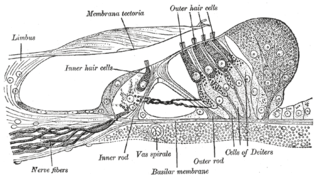
The nervous system is the part of an animal that coordinates its actions by transmitting signals to and from different parts of its body. The nervous system detects environmental changes that impact the body, then works in tandem with the endocrine system to respond to such events. Nervous tissue first arose in wormlike organisms about 550 to 600 million years ago. In vertebrates it consists of two main parts, the central nervous system (CNS) and the peripheral nervous system (PNS). The CNS consists of the brain and spinal cord. The PNS consists mainly of nerves, which are enclosed bundles of the long fibers or axons, that connect the CNS to every other part of the body. Nerves that transmit signals from the brain are called motor or efferent nerves, while those nerves that transmit information from the body to the CNS are called sensory or afferent. Spinal nerves serve both functions and are called mixed nerves. The PNS is divided into three separate subsystems, the somatic, autonomic, and enteric nervous systems. Somatic nerves mediate voluntary movement. The autonomic nervous system is further subdivided into the sympathetic and the parasympathetic nervous systems. The sympathetic nervous system is activated in cases of emergencies to mobilize energy, while the parasympathetic nervous system is activated when organisms are in a relaxed state. The enteric nervous system functions to control the gastrointestinal system. Both autonomic and enteric nervous systems function involuntarily. Nerves that exit from the cranium are called cranial nerves while those exiting from the spinal cord are called spinal nerves.

Perception is the organization, identification, and interpretation of sensory information in order to represent and understand the presented information, or the environment.

Signal transduction is the process by which a chemical or physical signal is transmitted through a cell as a series of molecular events, most commonly protein phosphorylation catalyzed by protein kinases, which ultimately results in a cellular response. Proteins responsible for detecting stimuli are generally termed receptors, although in some cases the term sensor is used. The changes elicited by ligand binding in a receptor give rise to a signaling cascade, which is a chain of biochemical events along a signaling pathway. When signaling pathways interact with one another they form networks, which allow cellular responses to be coordinated, often by combinatorial signaling events. At the molecular level, such responses include changes in the transcription or translation of genes, and post-translational and conformational changes in proteins, as well as changes in their location. These molecular events are the basic mechanisms controlling cell growth, proliferation, metabolism and many other processes. In multicellular organisms, signal transduction pathways have evolved to regulate cell communication in a wide variety of ways.

The sensory nervous system is a part of the nervous system responsible for processing sensory information. A sensory system consists of sensory neurons, neural pathways, and parts of the brain involved in sensory perception. Commonly recognized sensory systems are those for vision, hearing, touch, taste, smell, and balance. In short, senses are transducers from the physical world to the realm of the mind where we interpret the information, creating our perception of the world around us.
A taxis is the movement of an organism in response to a stimulus such as light or the presence of food. Taxes are innate behavioural responses. A taxis differs from a tropism in that in the case of taxis, the organism has motility and demonstrates guided movement towards or away from the stimulus source. It is sometimes distinguished from a kinesis, a non-directional change in activity in response to a stimulus.
A chemoreceptor, also known as chemosensor, is a specialized sensory receptor cell which transduces (converts) a chemical substance and generates a biological signal. This signal may be in the form of an action potential if the chemoreceptor is a neuron, or in the form of a neurotransmitter that can activate a nearby nerve fiber if the chemosensor is a specialized sensory receptor cell, such as the taste receptor in a taste bud or in an internal peripheral chemoreceptor such as the carotid body. In more general terms, a chemosensor detects toxic or hazardous chemicals in the internal or external environment of the human body and transmits that information to the central nervous system,, in order to expel the biologically active toxins from the blood, and prevent further consumption of alcohol and/or other acutely toxic recreational intoxicants.
A receptor potential, also known as a generator potential, a type of graded potential, is the transmembrane potential difference produced by activation of a sensory receptor.

In physiology, a stimulus is a detectable change in the internal or external environment. The ability of an organism or organ to respond to external stimuli is called sensitivity. When a stimulus is applied to a sensory receptor, it normally elicits or influences a reflex via stimulus transduction. These sensory receptors can receive information from outside the body, as in touch receptors found in the skin or light receptors in the eye, as well as from inside the body, as in chemoreceptors and mechanoreceptors. An internal stimulus is often the first component of a homeostatic control system. External stimuli are capable of producing systemic responses throughout the body, as in the fight-or-flight response. In order for a stimulus to be detected with high probability, its level must exceed the absolute threshold; if a signal does reach threshold, the information is transmitted to the central nervous system (CNS), where it is integrated and a decision on how to react is made. Although stimuli commonly cause the body to respond, it is the CNS that finally determines whether a signal causes a reaction or not.
In physiology, sensory transduction is the conversion of a sensory stimulus from one form to another. Transduction in the nervous system typically refers to stimulus-alerting events wherein a physical stimulus is converted into an action potential, which is transmitted along axons towards the central nervous system for integration. It is a step in the larger process of sensory processing.
Stimulus modality, also called sensory modality, is one aspect of a stimulus or what is perceived after a stimulus. For example, the temperature modality is registered after heat or cold stimulate a receptor. Some sensory modalities include: light, sound, temperature, taste, pressure, and smell. The type and location of the sensory receptor activated by the stimulus plays the primary role in coding the sensation. All sensory modalities work together to heighten stimuli sensation when necessary.
A mechanoreceptor is a sensory receptor that responds to mechanical pressure or distortion. Normally there are four main types in glabrous, or hairless, mammalian skin: lamellar corpuscles, tactile corpuscles, Merkel nerve endings, and bulbous corpuscles. There are also mechanoreceptors in hairy skin, and the hair cells in thoreceptors of primates like rhesus monkeys and other mammals are similar to those of humans and also studied even in early 20th century anatomically and neurophysiologically.
A thermoreceptor is a non-specialised sense receptor, or more accurately the receptive portion of a sensory neuron, that codes absolute and relative changes in temperature, primarily within the innocuous range. In the mammalian peripheral nervous system, warmth receptors are thought to be unmyelinated C-fibres, while those responding to cold have both C-fibers and thinly myelinated A delta fibers. The adequate stimulus for a warm receptor is warming, which results in an increase in their action potential discharge rate. Cooling results in a decrease in warm receptor discharge rate. For cold receptors their firing rate increases during cooling and decreases during warming. Some cold receptors also respond with a brief action potential discharge to high temperatures, i.e. typically above 45°C, and this is known as a paradoxical response to heat. The mechanism responsible for this behavior has not been determined.

Sensory neurons also known as afferent neurons are neurons that convert a specific type of stimulus, via their receptors, into action potentials or graded potentials. This process is called sensory transduction. The cell bodies of the sensory neurons are located in the dorsal ganglia of the spinal cord.
Sensation is an animal's, including humans', detection of external or internal stimulation. It is different from perception, which is about making sense of, or describing, the stimulation.
Neural adaptation or sensory adaptation is a gradual decrease over time in the responsiveness of the sensory system to a constant stimulus. It is usually experienced as a change in the stimulus. For example, if a hand is rested on a table, the table's surface is immediately felt on the skin. After a little while though this is no longer felt. The sensory neurons that initially respond are no longer stimulated to respond; this is an example of neural adaptation.

Plant perception or Plant Gnosophysiology is the ability of plants to sense and respond to the environment to adjust their morphology, physiology, and phenotype accordingly. Other disciplines such as plant physiology, ecology and molecular biology are used to assess this ability. Plants react to chemicals, gravity, light, moisture, infections, temperature, oxygen and carbon dioxide concentrations, parasite infestation, disease, physical disruption, sound, and touch.

Group C nerve fibers are one of three classes of nerve fiber in the central nervous system (CNS) and peripheral nervous system (PNS). The C group fibers are unmyelinated and have a small diameter and low conduction velocity, whereas Groups A and B are myelinated. Group C fibers include postganglionic fibers in the autonomic nervous system (ANS), and nerve fibers at the dorsal roots. These fibers carry sensory information.
Stimulus filtering occurs when an animal’s nervous system fails to respond to stimuli that would otherwise cause a reaction to occur. The nervous system has developed the capability to perceive and distinguish between minute differences in stimuli, which allows the animal to only react to significant impetus. This enables the animal to conserve energy as it is not responding to unimportant signals.












